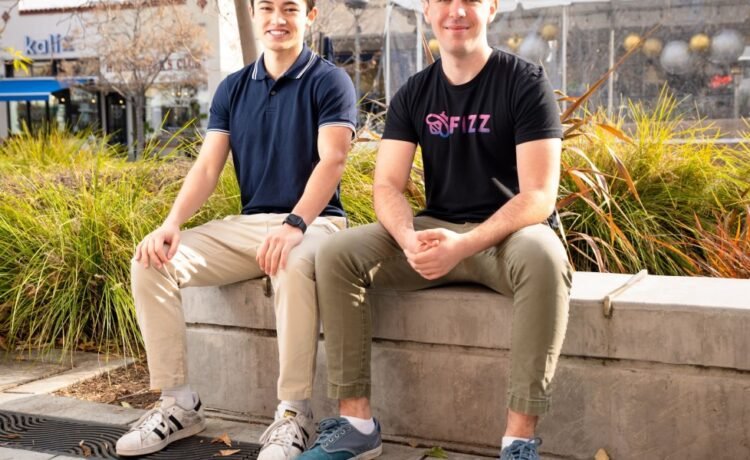
Teddy Solomon knew he was onto something when he visited a Palo Alto shop to return his bike at the end of a school year at Stanford. Trying to make a couple bucks off his beat-up two-wheeler, Solomon was surprisingly turned away from the shop.
“They basically told me straight up, ‘Go onto Fizz to sell your bike,’” Solomon recalled. “You’re gonna get a much better value for it. We will scam you here because everyone is trying to sell their bikes,” they told him.
Unbeknownst to the bike-shop worker, Solomon, 22, and a Stanford dropout, had cofounded Fizz, an anonymous social media app for Gen Zers that is active across 240 college campuses and 60 high schools. Built as a way for young people to exchange information about events and school culture, Fizz promised to be the common denominator among students finding their footing on a new campus. The app, still evolving to meet the needs of its audience, just rolled out a marketplace feature. Since the marketplace’s March to May rollout, the feature has over 50,000 item listings, which has generated over 150,000 direct messages across users.
“It all boils back to the fact that there were peer-to-peer commerce platforms before,” Solomon told Fortune. “They no longer really exist on college campuses in a lot of ways, and they no longer exist within Gen Z.”
That generation of college students and young professionals have certainly abandoned sites like Facebook, which has been outranked by Instagram, TikTok, and YouTube as Gen Z’s social media platforms of choice. But that doesn’t mean that the platform is obsolete. Facebook’s 40 million daily young adult users ages 18 to 29 in the U.S. and Canada have lingered on the site, many for the sole purpose of browsing the marketplace. They’ve helped boost Facebook Marketplace to four times the monthly users as Amazon, and it’s on its way to surpassing eBay for resale e-commerce’s top spot in the U.S.
But Fizz isn’t trying to replicate Facebook’s bumper numbers on its way to success. Instead, the site’s budding marketplace makes the argument for a new wave of social media beyond superficial “likes” and interactions. Solomon wants Fizz to be a place for an online meet-cute or where frat boys and dorm shut-ins find common ground through the sale of a used textbook—an oasis for community that is as functional as it is feel-good. It’s a goal that might be as lofty as the one a young Mark Zuckerberg made for “TheFacebook” in his own brief college career.
“We’re our own entity,” Solomon said. “And we’ve seen that all of these legacy platforms—Facebook Marketplace included—are really falling out of favor with Gen Z. They’re not trusted, and they’re really a thing of the past.”
E-motional e-commerce
Solomon and co-founder Ashton Cofer—who met in a quickly abandoned group chat for Stanford freshman—created Fizz in 2021. Victims of pandemic-era remote learning, the idea for the social media site was to build a platform for connection and fight the generation’s loneliness epidemic, Solomon explained. The promise of anonymity among its users would prevent cliques from forming and dissolve the pressure among students to impress one another. Requiring users to login with an academic email address, Fizz was a protected space for just students.
But the app also promised utility: a one-stop shop to exchange information about classes and events on top of being a place to slap frivolous campus-specific memes or gush about a chemistry lab crush. Come for the comradery, stay for the practicality.
“We always knew it was going to be a place where a lot more than just posting about parties and cracking jokes happened,” Solomon said.
By 2023, grown-ups started to take Fizz seriously. The company raised $41.5 million in funding, and tech investor Rakesh Mathur stepped in as CEO. The app was on about a dozen college campuses in 2022, a figure that has increased 20-fold today.
At the nexus of Fizz’s promise of both community and utility is its budding e-commerce platform, which, until months ago, was just part of the app’s main feed. Now, like Facebook Marketplace, Fizz users can upload images of something they want to sell, and interested parties can message them through the app to purchase the item. Fizz has not yet monetized the feature.
Gen Z—with a love of thrifting, environmental consciousness, and knickknacks—has embraced second-hand resale platforms. It’s a generation that, despite contributing to the rise of influencers, has opted for authenticity and eschewed luxury goods. It’s a part of the generation that, despite the growth of e-commerce platforms like TikTok Shop, are seeking sentimentality—or at least a good story—behind their belongings, Solomon said.
“Through talking to a lot of college students over the past couple of years, what I found from them is they really value the peer-to-peer component, meaning there is an emotional value to the items that you have, but you are willing to give them up,” he said.
It’s this subtle emotional bent to the platform that Charles Lindsey, associate professor of marketing at University at Buffalo School of Management, believes can separate it from e-commerce competitors. Meaningful connections are the key to keeping people loyal to the online community, which, in turn, helps Fizz retain and grow a strong base of users.
“We have our own standalone, dedicated built-in constituency group there that are interacting with us and identify with us emotionally and socially,” Lindsey told Fortune. “Because something about our social media platform is differentiated enough from the other social media platforms that they use us.”
The ‘anti-Facebook’
A social media site tailored just for college students? The promise of connecting a disparate academic community? Fizz sounds an awful lot like another platform founded 20 years ago with the same mission, Lindsey said. While Facebook’s initial traction allowed it to reach 1 million users in its first year, its now 3 billion monthly active user base has both obviously contributed to its success—and brought it farther away from its original goal.
“It’s just so big, and people, I think, use it because it’s so big,” Lindsey said. “And there’s not quite the social emotional attachment anymore.”
But Fizz’s success as a startup and a burgeoning e-commerce platform shouldn’t necessarily mimic Facebook’s meteoric rise if it wants to find success, Lindsey argued. “It’s the anti-Facebook in a way,” he said.
“There is definitely a tension between that value proposition, and how does a social media platform like Fizz grow while still keeping its promise,” Lindsey said.
Fizz has experienced growing pains that dilute its promise of wholesome community building. Last month, Fizz disrupted a Vermont high school after students used the app to mock disabled students and speculate on teachers’ private lives. University of North Carolina’s president plans to ban the app and similar budding social media sites over cyberbullying concerns.
Solomon said UNC’s 16-school system never had Fizz on its campuses to begin with, and the Vermont high school was one of two communities out of 300 the company has had to shut down over conduct concerns. To address bullying and harassment, Fizz has AI that removes 75% of content that violates community guidelines, as well as 4,000 volunteer moderators.
Though the app risks becoming an echo chamber for mistreatment, Solomon argues its intimate setting among solely other students makes users feel safer than buying items from strangers on other peer-to-peer platforms. The app not only hopes to be a beacon of community security, its future will ultimately rely on it.
“People want something efficient,” Solomon said. “And people want to buy and sell from people that they trust.”






